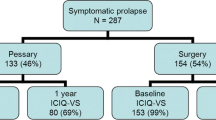Abstract
Introduction and hypothesis
The impact of surgery on pelvic floor muscle (PFM) function remains uncertain. There is a pressure differential along the length of the vagina, influenced by surrounding active and passive tissue structures, giving rise to a pressure profile. The aim of this study is to determine if an intravaginal pressure sensor, femfit®, can measure differences in pressure profiles before and after surgery for pelvic organ prolapse (POP).
Methods
This pilot study includes 22 women undergoing POP surgery. Intravaginal pressure profiles were measured with femfit® pre- and post-surgery and differences tested using paired Student’s t-tests. Patients completed validated questionnaires for vaginal, bowel, and urinary incontinence symptoms pre- and post-POP surgery and a femfit® usability questionnaire.
Results
Sixteen sets of vaginal pressure data were analysed. The highest pressure generated was identified as the peak PFM pressure, whilst all sensor measurements provided a pressure profile. Intra-abdominal pressure (IAP) was measured by the most distal sensor, 8. On average, the difference between peak PFM pressure and IAP was significantly greater post-surgery (p < 0.01). Urinary and vaginal symptom questionnaire scores were significantly improved after POP surgery. Femfit® usability questionnaires demonstrated high levels of patient acceptability.
Conclusions
Women generate higher peak PFM pressures compared to IAP post-POP surgery, with pressure profiles that are comparable to women without POP. This metric might be useful to assess the outcome of POP surgery and encourage women to maintain this profile via PFM training, potentially reducing POP recurrence risk.



Similar content being viewed by others
References
Hagen S, Stark D. Conservative prevention and management of pelvic organ prolapse in women. Cochrane Database Syst Rev. 2011;12. https://doi.org/10.1002/14651858.CD003882.pub4.
Dumoulin C, Cacciari LP, Hay-Smith EJC. Pelvic floor muscle training versus no treatment, or inactive control treatments, for urinary incontinence in women. Cochrane Database Syst Rev. 2018;10. https://doi.org/10.1002/14651858.CD005654.pub4.
Wu JM, Vaughan CP, Goode PS, et al. Prevalence and trends of symptomatic pelvic floor disorders in US women. Obstet Gynecol. 2014;123(1):141–8. https://doi.org/10.1097/AOG.0000000000000057.
Fialkow MF, Newton KM, Lentz GM, Weiss NS. Lifetime risk of surgical management for pelvic organ prolapse or urinary incontinence. Int Urogynecol J. 2008;19:437–40. https://doi.org/10.1007/s00192-007-0459-9.
Bump RC, Mattiasson A, Bo K, Brubaker LP, DeLancey JOL, Klarskov P, et al. The standardization of terminology of female pelvic organ prolapse and pelvic floor dysfunction. Am J Obstet Gynecol. 1996;175:10–7. https://doi.org/10.1016/S0002-9378.
Guaderrama NM, Nager CW, Liu J, Pretorius DH, Mittal RK. Neurourol Urodynam. 2005;24:243–7. https://doi.org/10.1002/nau.20112.
Cacciari LP, Kruger J, Goodman J, Budgett D, Dumouin C. Reliability and validity of intravaginal pressure measurements with a new intravaginal pressure device: The Femfit®. Neurourol Urodynam. 2019;39(1):1–8. https://doi.org/10.1002/nau.24179.
Ashton-Miller JA, Howard D, DeLancey JOL. The functional anatomy of the female pelvic floor and stress incontinence control system. Scand J Uro Nephro. 2011;35(207):1–7. https://doi.org/10.1080/003655901750174773.
Kruger J, Budgett D, Goodman J, Bo K. Can you train the pelvic floor muscles by contracting other related muscles? Neurourol Urodynam. 2019;38:677–83. https://doi.org/10.1002/nau.23890.
Sung VW, Rardin CR, Raker CA, LaSala CA, Myers DL. Changes in bowel symptoms 1 year after rectocele repair. Am J Obstet Gynecol. 2012;207:423.e1–5.
Hagen S, Stark D, Glazener C, Dickson S, et al. Individualised pelvic floor muscle training in women with pelvic organ prolapse (POPPY): a multicentre randomised controlled trial. The Lancet. 2014;383(9919):796–806. https://doi.org/10.1016/S0140-6736(13)61977-7.
Kruger J, Hayward L, Nielsen P, Loiselle D, Kirton R. Design and development of a novel intravaginal pressure sensor. Int Urogynecol J. 2013;24:1715–21. https://doi.org/10.1007/s00192-013-2097-8.
Hsu Y, Coleman TJ, Hitchcock RW, Heintz K, Shaw JM, Nygaard IE. Clinical evaluation of a wireless intravaginal pressure transducer. Int Urogynecol. 2012;23(12):1741–7. https://doi.org/10.1007/s00192-012-1811-2.
Coleman TJ, Thomsen JC, Maass SD, Hsu Y, Nygaard IE, Hitchcock RW. Development of a wireless intravaginal transducer for monitoring intra-abdominal pressure in women. Biomed Microdevices. 2011;14(2):347–55. https://doi.org/10.1007/s10544-011-9611-x.
Acknowledgements
Jaijus Pallippadam Johny and John Thompson assisted with data analysis.
Funding for this study was provided by a NZ government grant from Ministry of Business and Innovation and Employment (Smart Sensors for the Medical Industry).
Author information
Authors and Affiliations
Corresponding author
Ethics declarations
Conflict of interest
Joy Marriott has no conflict of interest or financial disclaimer to declare.
DB, PN, JS, LH. and JK hold shares in Junofem Ltd.
Additional information
Publisher’s note
Springer Nature remains neutral with regard to jurisdictional claims in published maps and institutional affiliations.
Supplementary Information
ESM 1
PDF 68.2 kb
Rights and permissions
About this article
Cite this article
Marriott, J., Pedofsky, L., Smalldridge, J. et al. Assessing vaginal pressure profiles before and after prolapse surgery using an intravaginal pressure sensor (femfit®). Int Urogynecol J 32, 3037–3044 (2021). https://doi.org/10.1007/s00192-020-04576-y
Received:
Accepted:
Published:
Issue Date:
DOI: https://doi.org/10.1007/s00192-020-04576-y




